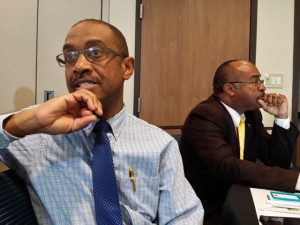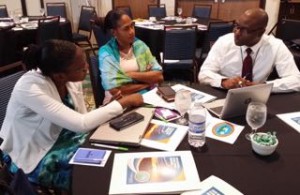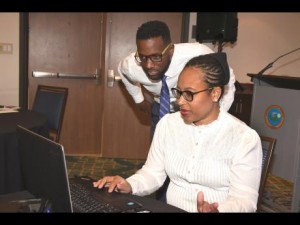
Communicating the Weather and Climate Change: How Can We Bridge the Gap?
August 31st, 2018
It’s not easy, we know. Getting the word out, keeping the public informed about the latest developments in weather is a challenge, to say the least. Therefore, it was good to see the Meteorological Service of Jamaica make the effort to invite Jamaican journalists to a 2018 Weather and Climate Media Workshop recently. The turnout of journalists could have been better; it was a full day, with plenty of useful and detailed information, but not many stayed to the end. Having organized many media workshops during my working life, I can empathize.
The workshop was organized in collaboration with the Office of Disaster Preparedness and Emergency Management (ODPEM). Now, in the past, I have lambasted ODPEM for being too low-profile. I was particularly upset when we heard about an admittedly short-lived, late-night tsunami alert for Jamaica the following day. We could have drowned in our sleep! The “Met Office” has had its challenges too – almost two years ago, I wrote about the weather forecaster’s nightmare, the dilatory Hurricane Matthew.
One thing is for certain: with climate change, we can “expect the unexpected.” Don’t take anything for granted.

Director of the Meteorological Service of Jamaica Evan Thompson (foreground) answers a question, while Director General of ODPEM Major Clive Davis seems deep in thought. (My photo)
At the workshop, it struck me (not for the first time) that there is a gap between scientists – our meteorologists, in this case – and the media that is not easy to bridge. Major Clive Davis, Director General at ODPEM, acknowledged this in his remarks: “We have fallen short in our interactions with the media,” he observed. If anyone is to blame (and I don’t see it necessary to point fingers), it is, perhaps, both sides. The media has not been making much effort to get things right lately (not even headlines, or basic spelling) and some media houses seem preoccupied with sensational headlines, crime and anything vaguely political. But then, that’s nothing new.
The Met Service is unique in many ways. It is a bunch of scientists – specialists in sun, wind, rain – who deal with complicated maps and graphs all day and talk in a particularly impenetrable jargon. They are aware of this, however. The Met Service’s very nice website has a section devoted to “Often Misunderstood Weather Terms” as well as an impressive Glossary of terms in alphabetical order. This includes words like Isohyet and Vorticity, which might be suitable for spelling bee contestants. I cannot even pronounce the first one. However, I must candidly admit that I have trouble with the word “meteorological” itself (how many syllables does it even have?)

Dr. Tannecia Stephenson from the Climate Studies Group at the University of the West Indies (left) and Head of the Climate Branch at the Meteorological Service of Jamaica Jacqueline Spence talk to Gleaner reporter Paul Clarke at the workshop. (My photo)
At the same time, these particular scientists are duty bound to communicate with the general public, in the broadest possible way – as is ODPEM. If and when we remember that these agencies exist at all, it is at a time when drought, floods, storms are upon us, and everything is urgent. So, the Met Service needs to immediately translate its messages – not only the jargon but also the “what to do next” or “what can we expect” scenarios. How urgent is the situation? “Wishcasting” (a tendency to consume information that you are already expecting or hoping for) is one communication challenge. The public often has a selective memory, only remembering when the Met Office made a wrong forecast, even though nine times out of ten they forecast correctly. There are also unrealistic expectations, and this would apply to ODPEM too. I myself have been guilty of some of these tendencies!
Language apart, it is concepts that are important, too, especially in the context of climate change. I would suggest that there also needs to be an ongoing dialogue among scientists, the media, and the general public. Is this happening?
I learned at the workshop that the National Meteorological Centre (NMC) at Norman Manley International Airport (NMIA) in Kingston is contactable at any time. It is staffed “24/7″ on a shift system, so a media person or member of the public can talk to them at 3:00 a.m. if they so wish. There are usually at least two meteorologists at the NMC (“not enough,” it was conceded). There is another center at the Sangster International Airport in Montego Bay, primarily for observation purposes. Among the NMC’s duties is the need to provide information in real time to aeronautical interests, which is an obviously high priority. The “at least two” meteorologists provide continuous observations and recordings. Clearly, human resources are insufficient. Conflicting and rigorous duties mean that the staff is often overstretched. “Forecasters have to prioritize,” we are told.
On top of that, if you want to study Meteorology, you cannot do so in Jamaica; you have to go to the University of the West Indies’ Cave Hill Campus in Barbados. I hear also that the salary is not very attractive (just like journalists’ salaries!)

Head, Weather Branch, Meteorological Service of Jamaica, Kareen Gourzong, shares information with Director, Marketing and Communications, Caribbean Maritime University, and Journalist, Archibald Gordon, at a recent media workshop jointly hosted by the Met Service and Office of Disaster Preparedness and Emergency Management (ODPEM) at the Courtyard Marriot Hotel, New Kingston. (Photo: Gleaner)
I also realized (not for the first time) that media houses themselves are overstretched and under-resourced. Archibald Gordon of Television Jamaica told us that his newsroom has only nine reporters per day, working in shifts. This is a “major media house”!
So, where should the twain meet? The journalists present suggested that both the Met Service and ODPEM should consider their audiences: “It’s about the receiver of the information,” said one. That receiver could be a young person; “from pickney upwards,” outreach should start in schools, was one suggestion. The weather can be put into an appealing package. Meteorologists should be media-savvy (and package themselves?) In other words, there needs to be a much greater focus on communication, rather than on the information itself. The Met Service and ODPEM must still control the narrative, however. The aim is to teach the public without “dumbing things down.”
And the media? I would suggest that the traditional media should try to get things right – first and foremost. A day or two after the workshop, I watched a live television news bulletin on the earthquake in Venezuela, which affected Trinidad & Tobago. The headline news story stressed that a tsunami alert was out for the area. In fact (as I learned on Twitter) the tsunami alert had been lifted two or three hours earlier. The newsroom has the ability to access up-to-date information. With today’s technology and communications, there is no excuse. In this case, I would think that a quick telephone call could have provided an accurate report. Ah, well.
Here’s hoping that, as a result of this workshop and smaller, everyday efforts, we will all get better at this. Our lives may depend on it, one day (although I am hoping it will not come to that).
Kudos to all at the Met Service and ODPEM for taking this on, and to the journalists who considered this significant enough to attend.
Tags: Archibald Gordon, Barbados, Cave Hill, Climate Change, disaster preparedness, earthquake, Hurricane Matthew, Jamaica, Kingston, Major Clive Davis, Meteorological Service of Jamaica, meteorologist, Montego Bay, National Meteorological Centre, Norman Manley International Airport, ODPEM, Office of Disaster Preparedness and Emergency Management, Sangster International Airport, social media, Television Jamaica, Trinidad and Tobago, tsunami, Twitter, University of the West Indies, Venezuela, weather forecast
The Gleaner reserves the right not to publish comments that may be deemed libelous, derogatory or indecent.
To respond to The Gleaner please use the feedback form.
One Response to “Communicating the Weather and Climate Change: How Can We Bridge the Gap?”
- We Are the Zoomers
- Living Online with Humans and Birds: NAOC 2020
- Human Trafficking and the Problem of Public Education
- Down Memory Lane
- Are We Ready to Recover from COVID-19?
- Road Safety Matters: Is Your Vehicle Safe?
- Sexual Harassment, Me Too, and the Minister’s Disturbing Giggle
- The Vulnerable Senior Citizens, Private Care Homes and COVID-19
- A Muddle Over Masks
- Here is Something Life-Saving You Can Do: Give Blood!



[…] and the Office of Disaster Preparedness and Emergency Management (ODPEM), who organized a great Weather and Climate Media Workshop recently. I gave a presentation on the need to communicate via social media – especially when time is […]